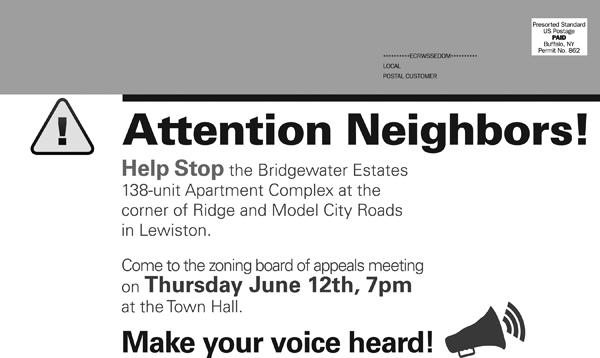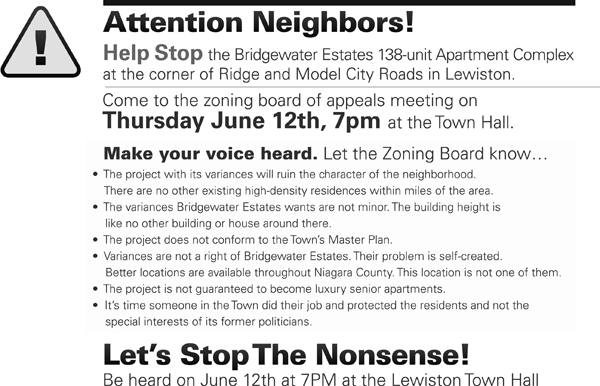 |
|
It is hard to believe that with a view of portable toilets Bridgewater will be a Senior Luxury Apartment complex. |
|
|
LEWISTON, NY: A crucial day is approaching for the high-density Bridgewater apartment building project, planned to be built on Rt. 104, near Model City Rd.
That day is June 12.
That is the day, or rather evening, at 7 pm, when, in town hall, the Lewiston Town Zoning Board of Appeals (ZBA) will consider extending and/or granting variances for the purported senior citizen complex that seeks 50 feet tall buildings built within 30 feet of neighbors.
If the ZBA shoots these two variances down, the project is all but dead. If the five member board approves them, it will head to court for a judge to decide if the whole process was illegal from the start.
There has been controversy over the Bridgewater project, most of it centering around the dealings of former town supervisor Steven L. Reiter, who, unknown to various boards at the time, was a silent partner in the project.
Last month, the matter wound up in state Supreme Court after the Lewiston International Business Park, Inc., owned by Modern Disposal owner, Sonja Washuta, commenced a lawsuit against the developers of Bridgewater and the Town claiming a violation of process and a conflict of interest, where Reiter, as supervisor, illegally fast tracked the project while he was an undisclosed partner in the project.
This week, the Business Park sent out fliers to thousands of town residents asking them to attend the zoning board hearing.
Attendance may be large since it is widely believed the project will wind up being not the promised "luxury senior housing" project, but a Section 8, low-income project.
High density, small land area, lots of people who don't work for a living, but are dependent on government, with a load of idle time, seems to many people what will be served up to the town when reality sets in.
This project, critics contend, is one that will make the Woods at Blairville, presently the single biggest crime-infested complex in town, look like a Sunday picnic. The Woods at Blairville is spread over more than a dozen acres in two story buildings. Bridgewater will be jammed on just 3.5 acres.
Huge, unheard of density, small area. Tall buildings. Busy street. Backing up to a landfill.
Nowhere for people to go.
Who will they be at Bridgewater?, critics ask. Seniors, who will pay $1500 a month to have a view of Modern Disposal's portable toilets, stored in rows of 100, scrap trucks, a giant landfill heaped with garbage, and a truck parking lot, or government-subsidized loafers, who don't pay anything; the government (i.e. you and I) paying their rent?
In town they say it. Go anywhere and you'll hear it. In coffee shops, restaurants, garages and taverns: What a field day that will be when 250 idlers come tramping into town from Niagara Falls, from Buffalo, from New York City.
Still, none of this is the concern of the ZBA and this June 12 meeting.
So what is their concern? The developers seek two variances, or exemptions from town zoning law. One: They want to build their apartments 50 feet tall which is taller than town law allows. These apartment buildings would be taller than any structure within the vicinity (if not the entire Town). Two: They want to build their apartments within 30 feet (29'-5 1/4") of the neighbor's property, which is a 150% variance,
Now, the following is a little technical, but, if the reader follows closely, he or she will see that the ZBA has little choice but to deny these two variances:
1. There has been no SEQRA (environmental) review by the ZBA. Bridgewater's developers claim the two variances they seek - 50 foot tall buildings within 30 feet of neighbors, are exempt from SEQRA. They are wrong.
The variances they seek are classified as Type II, which apply only to single-family, two-family or three-family residences. (6 NYCRR 617.5(c)(13)). But Bridgewater is 138 units, which is 46 times (135 units) above the Type II threshold.
It makes sense this large scale increase in density requires some study. The environmental issues that must be studied include traffic, noise, potential health issues to seniors (if this is to be a senior housing project) caused by truck exhaust, drainage impacts to adjacent property owners, increased police and fire services, increased utility needs, etc.
2. The Town Board adopted a Negative Declaration (no adverse environmental impact) for the site plan approval without any studies. The project was never subject to coordinated review. As supervisor, Reiter simply signed off on the Environmental Impact Statement saying there were no adverse environmental impacts arising from the project. He waived a traffic study, despite the fact there was a planned driveway to be used by (allegedly) 200 seniors coming out on a 55-mph speedway against Rt. 104 truck traffic.
Since there was no environmental review, the ZBA, by law, must conduct its own SEQRA review, (6 NYCRR 617.6(b)(4),) and the ZBA is required to take a "hard look" at the potential environmental impacts associated with the project before granting variances of any significance.
3. Apart from SEQRA, the variances (height and short side lot) should be denied. ZBA must weigh the benefit to the applicant against the detriment to the health, safety, and welfare of the neighborhood or community (Town Law § 267–b-3b.) In making its determination, the ZBA must consider:
a. whether an undesirable change will be produced in the character of the neighborhood or a detriment to nearby properties will be created;
b. whether the benefit sought by the applicant can be achieved by some other feasible method;
c. whether the requested area variance is substantial;
d. whether the proposed variance will have an adverse effect or impact on the physical or environmental conditions in the neighborhood; and
e. whether the alleged difficulty was self-created.
In granting a variance, the ZBA must grant the "minimum variance it shall deem necessary and adequate and at the same time preserve and protect the character of the neighborhood and the health, safety and welfare of the community." The variances create a detriment to the next door neighbor in that the enjoyment of that family residence will be ruined by the having a 138 units built within 30 feet of her property.
Other nearby homeowners will have to contend with traffic impacts, noise and other issues related to the sudden influx of 138 apartment dwellers and 240 cars. This is not what they bargained for when they purchased single family homes on larger lots, with the expectation of privacy and solitude in a rural setting.
4. Assuming a multi-family apartment complex is even allowed on the Reiter property, allowing three, 50 foot buildings, will produce an undesirable, inappropriate change in the character of the neighborhood, and one that runs counter to the official land use vision of the Town, adopted in the 2000 Comprehensive Plan and 2011 Comprehensive Plan Update, both of which state that residential development in the central and eastern portions of the Town should remain low density, with higher density developments centered around the Village and the Niagara River corridor.
5. Where a project necessitating variances will be out of character, or scale, with the surrounding area, and conflict with officially adopted plans, variances are routinely denied as representing an undesirable change in the neighborhood. There are no other existing, high-density residences within miles of the location
6. The benefit sought by Bridgewater can be achieved without variances: Smaller and fewer buildings would eliminate the need for variances and protect surrounding properties, while still allowing Bridgewater to develop multi-family senior housing, if that is their true intention.
7. To apply for a zoning variance one can always argue hardship. But this "hardship" was "self-created." It is a well-established principle of law that an owner who buys a property that already has the restrictions from which it later seeks to change, that that hardship is self-created. The developers were aware of the zoning restrictions on the property when they bought it from Reiter's mother. The fact that they thought Reiter, as supervisor, could legally, or illegally, skirt the law, is not hardship based on any conventional understanding of the word.
At the end of the day, Bridgewater Estates was planned to be a 138 unit project, costing $12.3 million to build. The developers' plan, according to their IDA application, is to refinance the project for $16.3 million, pulling out $4 million up front as a developers fee. Surely, this is part of the reason they want a high density project - in order to justify the large pull out of cash up front.
Even if it fails to attract a single senior, they get their upfront fee.
Even if it becomes a low income project, they make their $4 million.
And what about the Town of Lewiston?
Why, they can take the hindermost.
With Steve Reiter that's usually the general plan.
For now, let's see what the ZBA will do.
Stay tuned.
 |
| Mailer has been sent to town residents urging them to attend Zoning Board meeting. |
|
|
|



